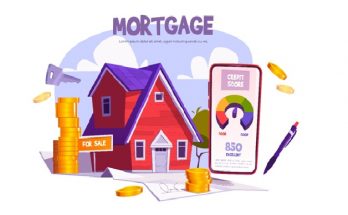If you’re in the market to buy a new property, one of the first things you’ll want to pay attention to is your credit score. Of course, a higher score is always better, but anything above 630 is generally considered “fair” or average, while a number above 690 is “good” and above 720 is “excellent.” If your credit score falls below these ranges, you may struggle to gain approval for a loan.

However, in the current market, even an average score might not be good enough. Scores below 675 can prove detrimental to qualifying for the best rates. What is a loan seeker to do, and what can you expect when you approach a mortgage lender with a suboptimal credit score?
Step One: Improve Your Credit
It sounds too good to be true, and also a bit like the obvious answer, but there are several quick fixes you can employ to bump your credit score up a few notches, and every little bit helps. Your mortgage lender can advise you on what steps will be most advantageous in your specific case, but some things to try are:
- Paying off debt. If you’re carrying debt on a credit card that you can afford to pay off, or if you have any old loans, now is a good time to settle them. However, do not close out the credit card accounts—this won’t do you any favors.
- No new credit cards or credit card purchases. Your existing cards are analyzed in comparison to their limits, and you want to keep as wide a disparity as possible there. As for opening a new line of credit, that can only reflect badly on your financial state.
- Dispute report errors. You can examine a copy of your credit report and determine what’s causing a lower score. If you’re being tagged for a late payment that you know is inaccurate, contest it. Things like that can make a big difference.
Step Two: Increase Your Down Payment
Can’t get the interest rate you want with the credit score you bring to the table? It may be a good idea to consider increasing your down payment. Of course, this poses challenges of its own—you might have to wait longer than you’d hoped to purchase a home so you can save up the requisite money, or you might have to drain your savings to make the required payment. But it is worth considering that when you make a larger down payment, you’ll qualify for lower interest rates, saving you money over time. You’ll also escape having to pay private mortgage insurance, or PMI. A safeguard for lenders to protect against borrowers defaulting on their loans, PMIs are typically waived with a down payment of 20% or more.
Step Three: Explore Government Assistance
There are plenty of government subsidies available to help people obtain a mortgage to purchase a home, and your mortgage lender can help you explore the options and decide if one of them is right for you. If you’re a first time homebuyer, look into the FHA Home Loan Program. Military veterans can receive assistance via VA loans. Ask your mortgage lender to discuss these programs with you.
Bad credit might feel like an insurmountable obstacle to buying a home, but the truth is that you do have options. Don’t be afraid to arrange a meeting with a mortgage lender and discuss where you are and where you want to be.



